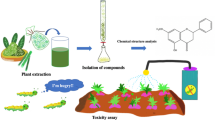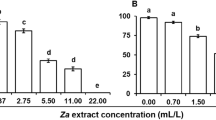Abstract
Itol A, an isoryanodane diterpene derived from Itoa orientalis Hemsl. (Flacourtiaceae), is a potential plant-based insecticide. However, the effect of itol A on the tobacco cutworm [Spodoptera litura (Fab.) (Lepidoptera: Noctuidae)], an important and widely distributed insect pest, remains unclear. In this study, the toxicity and inhibitory potency of itol A on S. litura were evaluated. The results indicated that itol A exhibited larvicidal activity against the third instar larvae in a concentration-dependent manner (LC50 875.48 mg/L at 96 h). Antifeedant activity also was observed, and the 24-h AFC50 values were 562.05 and 81.47 mg/L in the no-choice and choice experiments, respectively. The insect growth was inhibited after treatment of itol A, as reflected by long developmental periods, low-quality pupae, and various abnormalities. Itol A exerted ovicidal effect on S. litura, with an estimated LC50 of 759.30 mg/L. Itol A deterred oviposition in the choice experiment (ODI50 909.60 mg/L). Besides, the activities of α-amylase, general protease, superoxide dismutase (SOD), catalase (CAT), and peroxidase (POD) were inhibited after itol A treatment over time compared to controls, which may be a relevant mechanism underlying the toxicity of itol A toward S. litura. However, the activities of lipase, carboxylesterase (CarE), glutathione S-transferase (GST), and cytochrome P450 monooxygenase (P450) were increased. Taken together, these results suggest that itol A could be a good botanical pesticide to reduce the population of S. litura in integrated pest management programs.




Similar content being viewed by others
References
Abbas N, Samiullah SSA, Razaq M, Waheed A, Aslam M (2014) Resistance of Spodoptera litura (Lepidoptera: Noctuidae) to profenofos: relative fitness and cross resistance. Crop Prot 58:49–54
Akhtar Y, Isman MB, Paduraru PM, Nagabandi S, Nair R, Plettner E (2007) Screening of dialkoxybenzenes and disubstituted cyclopentene derivatives against the cabbage looper, Trichoplusia ni, for the discovery of new feeding and oviposition deterrents. J Agric Food Chem 55:10323–10330
Asperen KV (1962) A study of housefly esterases by means of a sensitive colorimetric method. J Insect Physiol 8:401–416
Ayil-Gutierrez BA, Sanchez-Teyer LF, Vazquez-Flota F, Monforte-Gonzalez M, Tamayo-Ordonez Y, Tamayo-Ordonez MC, Rivera G (2018) Biological effects of natural products against Spodoptera spp. Crop Prot 114:195–207
Baskar K, Ignacimuthu S (2012) Antifeedant, larvicidal and growth inhibitory effects of ononitol monohydrate isolated from Cassia tora L. against Helicoverpa armigera (Hüb.) and Spodoptera litura (Fab.) (Lepidoptera: Noctuidae). Chemosphere 88:384–388
Baskar K, Duraipandiyan V, Ignacimuthu S (2014) Bioefficacy of the triterpenoid friedelin against Helicoverpa armigera (Hüb.) and Spodoptera litura (Fab.) (Lepidoptera: Noctuidae). Pest Manag Sci 70:1877–1883
Bernfeld P (1955) Amylases, α and β. Methods Enzymol 1:149–158
Bradford MM (1976) A rapid and sensitive method for the quantitation of microgram quantities of protein utilizing the principle of protein-dye binding. Anal Biochem 72:248–254
Büyükgüzel E (2009) Evidence of oxidative and antioxidative responses by Galleria mellonella larvae to malathion. J Insect Physiol 102:152–159
Chai XY, Bai CC, Shi HM, Xu ZR, Ren HY, Li FF, Lu YN, Song YL, Tu PF (2008) Six insecticidal isoryanodane diterpenoids from the bark and twigs of Itoa orientalis. Tetrahedron 64:5743–5747
Chandran NN, Dana F, Lucie B, Eliska R, Ludek B (2018) Acute and (sub)chronic toxicity of the neonicotinoid imidacloprid on Chironomus riparius. Chemosphere 209:568–577
Cupp-Enyard C (2008) Sigma's non-specific protease activity assay-casein as a substrate. J Vis Exp 19:899
Datta R, Kaur A, Saraf I, Singh IP, Kaur S (2019) Effect of crude extracts and purified compounds of Alpinia galanga on nutritional physiology of a polyphagous lepidopteran pest, Spodoptera litura (Fabricius). Ecotoxicol Environ Saf 168:324–329
Dhaliwal GS, Jindal V, Dhawan AK (2010) Insect pest problems and crop losses: changing trends. Indian J Ecol 37:1–7
Dhir BC, Mohapatra HK, Senapati B (1992) Assessment of crop loss in groundnut due to tobacco caterpillar, Spodoptera litura (F.). Indian J Plant Prot 20:215–217
Finney DJ (1971) Probit Analysis, third edn. Cambridge University Press, London
Firake DM, Thubru DP, Behere GT (2017) Eco-toxicological risk and impact of pesticides on important parasitoids of cabbage butterflies in cruciferous ecosystem. Chemosphere 168:372–383
Gonzalez-Coloma A, Gutierrez C, Huebner H, Achenbach H, Terrero D, Fraga BM (1999) Selective insect antifeedant and toxic action of ryanoid diterpenes. J Agric Food Chem 47:4419–4424
Habig WH, Pabst MJ, Jakoby WB (1974) Glutathione S-transferases. The first enzymatic step in mercapturic acid formation. J Biol Chem 249:7130–7139
Han D, Rhee JS (1986) Characteristics of lipase-catalyzed hydrolysis of olive oil in AOT-isooctane reversed micelles. Biotechnol Bioeng 28:1250–1255
Hansen L, Hodgson E (1971) Biochemical characteristics of insect microsomes: N-and O-demethylation. Biochem Pharmacol 20:1569–1578
Hu QB, Ren SX, An XC, Qian MH (2007) Insecticidal activity influence of destruxins on the pathogenicity of Paecilomyces javanicus against Spodoptera litura. J Appl Entomol 131:262–268
Huang SH, Xian JD, Kong SZ, Li YC, Xie JH, Lin J, Chen JN, Wang HF, Su ZR (2014) Insecticidal activity of pogostone against Spodoptera litura and Spodoptera exigua (Lepidoptera: Noctuidae). Pest Manag Sci 70:510–516
Huang Q, Wang X, Yao X, Gong C, Shen L (2019) Effects of bistrifluron resistance on the biological traits of Spodoptera litura (Fab.) (Noctuidae: Lepidoptera). Ecotoxicology 28:323–332
Isman MB (2006) Botanical insecticides, deterrents, and repellents in modern agriculture and an increasingly regulated world. Annu Rev Entomol 51:45–66
Isman MB (2015) A renaissance for botanical insecticides? Pest Manag Sci 71:1587–1590
Isman MB, Koul O, Luczynski A, Kaminski J (1990) Insecticidal and antifeedant bioactivities of neem oils and their relationship to azadirachtin content. J Agric Food Chem 38(6):1406–1411
Joseph B, Sujatha S (2012) Insight of botanical based biopesticides against economically important pest. Int J Pharm Life Sci 3:2138–2148
Kaleeswaran G, Firake DM, Sanjukta R, Behere GT, Ngachan SV (2018) Bamboo-leaf prickly ash extract: a potential bio-pesticide against oriental leaf worm, Spodoptera litura (Fabricius) (Lepidoptera: Noctuidae). J Environ Manag 208:46–55
Kaur T, Kaur J, Kaur A, Kaur S (2016) Larvicidal and growth inhibitory effects of endophytic Aspergillus niger on a polyphagous pest, Spodoptera litura. Phytoparasitica 44:465–476
Kilani-Morakchi S, Bezzar-Bendjazia R, Ferdenache M, Aribi N (2017) Preimaginal exposure to azadirachtin affects food selection and digestive enzymes in adults of Drosophila melanogaster (Diptera: Drosophilidae). Pestic Biochem Physiol 140:58–64
Koul O, Singh R, Kaur B, Kanda D (2013) Comparative study on the behavioral response and acute toxicity of some essential oil compounds and their binary mixtures to larvae of Helicoverpa armigera, Spodoptera litura and Chilo partellus. Ind Crop Prod 49:428–436
Ling SQ, Xu YN, Gu YP, Liu SY, Tang WW (2018) Toxicity and biochemical effects of itol A on the brown planthopper, Nilaparvata lugens (Stål) (Hemiptera: Delphacidae). Pestic Biochem Physiol 152:90–97
Ma YF, Xiao C (2013) Push-pull effects of three plant secondary metabolites on oviposition of the potato tuber moth, Phthorimaea operculella. J Insect Sci 13:128
Nasr M, Sendi JJ, Moharramipour S, Zibaee A (2017) Evaluation of Origanum vulgare L. essential oil as a source of toxicant and an inhibitor of physiological parameters in diamondback moth, Plutella xylustella L. (Lepidoptera: Pyralidae). J Saudi Soc Agric Sci 16:184–190
Pavela R, Vrchotová N (2013) Insecticidal effect of furanocoumarins from fruits of Angelica archangelica L. against larvae Spodoptera littoralis Boisd. Ind Crop Prod 43:33–39
Pavela R, Waffo-Teguo P, Biais B, Richard T, Mérillon J (2017) Vitis vinifera canes, a source of stilbenoids against Spodoptera littoralis larvae. J Pest Sci 90:961–970
Rizvi SAH, Ling S, Tian F, Liu J, Zeng (2019) Interference mechanism of Sophora alopecuroides L. alkaloids extract on host finding and selection of the Asian citrus psyllid Diaphorina citri Kuwayama (Hemiptera: Psyllidae). Environ Sci Pollut Res 26:1548–1557
Ruttanaphan T, Pluempanupat W, Bullangpoti V (2018) Cypermethrin resistance in Spodoptera litura (Fabricius) (Lepidoptera: Noctuidae) from three locations in Thailand and detoxification enzyme activities. Agric Nat Resour 52:484–488
Senthil-Nathan S (2013) Physiological and biochemical effect of neem and other Meliaceae plants secondary metabolites against Lepidopteran insects. Front Physiol 4:359
Shah FM, Razaq M, Ali Q, Shad SA, Aslarn M, Hardy ICW (2019) Field evaluation of synthetic and neem-derived alternative insecticides in developing action thresholds against cauliflower pests. Sci Rep 9:7684
Sintim OH, Tashiro T, Motoyama N (2009) Response of the cutworm Spodoptera litura to sesame leaves or crude extracts in diet. J Insect Sci 9:52
Su T, Mulla MS (1998) Ovicidal activity of neem products (azadirachtin) against Culex tarsalis and Culex quinquefasciatus (Diptera: Culicidae). J Am Mosq Control Assoc 14:204–209
Suganthy M, Sakthivel P (2013) Field evaluation of biopesticides against tobacco caterpillar, Spodoptera litura Fab. infesting Gloriosa superba (Linn.). J. Biopestic 6:90–95
Suman DS, Wang Y, Bilgrami AL, Gaugler R (2013) Ovicidal activity of three insect growth regulators against Aedes and Culex mosquitoes. Acta Trop 128:103–109
Tang W, Wei X, Xu H, Zeng D, Long L (2009) 13-Deoxyitol A, a new insecticidal isoryanodane diterpene from the seeds of Itoa orientalis. Fitoterapia 80:286–289
Tian F, Wang Z, Li C, Liu J, Zeng X (2019) UDP-Glycosyltransferases are involved in imidacloprid resistance in the Asian citrus psyllid, Diaphorina citri (Hemiptera: Lividae). Pestic Biochem Physiol 154:23–31
Usherwood PN, Vais H (1995) Towards the development of ryanoid insecticides with low mammalian toxicity. Toxicol Lett 82-83:247–254
Zou C, Wang Y, Zou H, Ding N, Geng N, Cao C, Zhang G (2019) Sanguinarine in Chelidonium majus induced antifeeding and larval lethality by suppressing food intake and digestive enzymes in Lymantria dispar. Pestic Biochem Physiol 153:9–16
Funding
This work was generously supported by Key project of Guangxi Natural Science Foundation [No. 2017GXNSFDA198049] and grants from the National Natural Science Foundation of China [No. 31660529].
Author information
Authors and Affiliations
Contributions
Si-Quan Ling and Dong-Qiang Zeng conceived, designed, and performed the experiments, Wen-Wei Tang gives the direction of research and reviewed the manuscript, and Bo He helps in analyzing the manuscript.
Corresponding author
Additional information
Responsible Editor: Giovanni Benelli
Publisher’s note
Springer Nature remains neutral with regard to jurisdictional claims in published maps and institutional affiliations.
Rights and permissions
About this article
Cite this article
Ling, SQ., He, B., Zeng, DQ. et al. Effects of botanical pesticide itol A against the tobacco cutworm, Spodoptera litura (Fab.). Environ Sci Pollut Res 27, 12181–12191 (2020). https://doi.org/10.1007/s11356-020-07824-2
Received:
Accepted:
Published:
Issue Date:
DOI: https://doi.org/10.1007/s11356-020-07824-2




